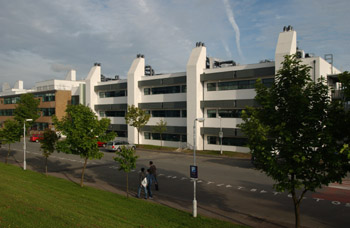LEC Pioneers Scheme To Reduce Carbon Footprint

Lancaster Environment Centre (LEC) is leading the field by working to cut back on greenhouse gas emissions at its newly-developed building complex on the Lancaster University campus.
The Lancaster Environment Centre is a partnership between the University and the Centre for Ecology and Hydrology (CEH). It brings together around 400 researchers who are working to address many of the major environmental challenges of the 21st century, especially those related to environmental change, sustainable management of resources (water, energy), chemicals management, sustainable agriculture, biodiversity and ecosystem function.
Now they are to use their expertise and that of others on campus to cut back on energy use in their own building, and elsewhere within the university after commissioning a report to assess the carbon footprint of LEC’s activities.
The in-depth survey was carried out by the LEC-based consultancy Small World, and examined everything from gas and electricity consumption to purchase of consumables, use of laboratory equipment and staff commuting. It assessed the amount of greenhouse gases being produced by these activities and reported their impact in tonnes of carbon dioxide equivalent.
The survey demonstrates that the highest emissions came from electricity consumption, giving an annual production of the equivalent of over 5,000 tonnes of carbon dioxide. This is partly due to the use of highly specialised, often energy-demanding equipment which underpins much of the research underway on site. Around 750 students are involved in training programmes in the Centre.
The University’s Vice-Chancellor Professor Paul Wellings said: “We takes the issue of climate change very seriously and it is important that a University with a high profile environmental research and training programme demonstrates best practice in this area. We have a wide range of expertise here at LEC and elsewhere on the campus and we intend to use it to benefit not just the University but also the broader community.”
The in-depth survey was carried out by the LEC-based consultancy Small World, and examined everything from gas and electricity consumption to purchase of consumables, use of laboratory equipment and staff commuting.
Small World’s Director Mike Berners-Lee said the best emissions savings are not always to be found in the most obvious places.
“It isn’t just a question of getting people to turn off the lights when they leave a room. There are a number of different issues to look at from the way in which people travel to the things the organisation buys and consumes.”
“Just by being aware of their energy consumption, the people who work in LEC could probably save about 10 per cent. Then we can make more substantial reductions through looking at targeted areas in more detail.”
A Carbon Management Team has now been set up to tackle the issue for LEC and the broader community, with members from across LEC and the University Estates Department. LEC is a partnership between the University and the Natural Environment Research Council’s Centre for Ecology and Hydrology, which is also based in the building.
The University’s Environmental Manager Jonathan Mills said: “We will consider ways to reduce demand for energy and also look at the supply, which could mean switching to a renewable energy source. This is an opportunity to look at usage at LEC and learn the lessons of energy reduction for the rest of campus.”
A recent survey of staff and students showed that over half felt that the University’s climate change policy is important to how they feel about working or studying at Lancaster.